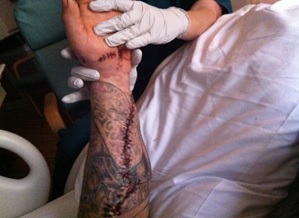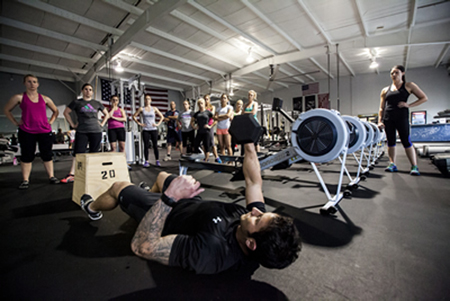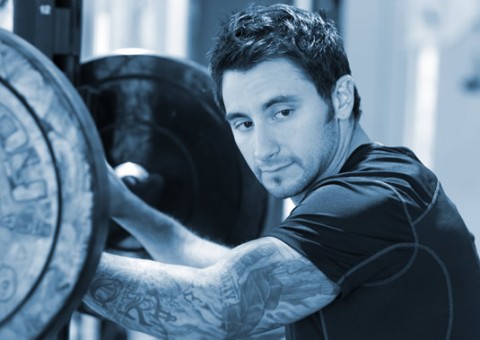This wasn’t how it was supposed to happen. That fast: the catastrophic blast flung Rob Stock off his position on an embankment in eastern Afghanistan, and as the soldier rose to spit out a mouthful of dirt and grit, he realized he was actually tasting his own shattered teeth. Worse, the Navy SEAL’s left arm had been flayed open, arteries and nerves and meat severed in a massive gaping wound. That fast: from three years of steadily doing his job to the grenade misfire that changed everything. That fast: fighting through shock and burn to apply a life-saving tourniquet.
Then, waking up to the slow, painstaking process of recovery.
“It was frustrating because it wasn’t like I had a debilitating disease where I slowly got very bad over time — I was fine one second, and then nothing the next. My brain still knew what I should be able to do, but I couldn’t physically do it,” says Stock. “I knew it wasn’t going to be fast — and that was kind of an aggravating point for me, because once you’re a SEAL, you want everything yesterday.”
Now retired from active duty, Stock recounts the details of that long rehabilitation from his home in Virginia Beach, VA. Remarkably, he’s resumed the vigorous pace of his SEAL training as the driving force behind The Human Performance Initiative (HPI), an innovative gym created by Stock and his wife, Nicole. With HPI, they’ve adapted the tactical and conditioning methods used by Special Operations Units into safely-managed workouts that target everyone from competitive athletes to buttoned-down executives.
Stock’s story is one that’s marked by extremes: leaving a comfortable desk job behind to serve downrange with the SEAL teams; pushing to be among the strongest and fastest before coping with a total loss of function.
Speed and conquering obstacles were Stock’s main priorities when — in the wake of 9/11 — he felt duty-bound to push for a role beyond his nine-to-five civilian life. “I knew I wanted to do something in the Special Forces realm,” Stock says. “I was looking at the different schools and pipelines in, and the things that were most important to me were ‘how fast can I get [to the front]?’ and ‘what is the degree of difficulty?’ And that led me to BUD/S.”
Motivated by the high-attrition rate of BUD/S (Basic Underwater Demolition/SEAL Training, which has a washout rate estimated between 70-85%), Stock bypassed the opportunity to use his mechanical engineering degree on the SEALS’ more deliberate Officer Candidate track, opting instead to enlist and head directly to boot camp. There, the former high school and collegiate wrestler succeeded based in part on his understanding of the balance between individual and team goals.
“With the weekly physical tests — obstacle course runs or swims or timed runs — it becomes very individual-based. You want to achieve the very best times you can and everyone out there is putting out. But there are hard group/team events where everyone has to pull together, like during Hell Week, so you get the best of both worlds,” says Stock. “BUD/S hasn’t really changed — it’s selection for a reason. You throw away all good times and all that stuff and you want it to be hard for the right reasons. You want people to fail, you want them to pack up and quit, because you probably don’t want that guy on the teams if they are going to quit.”
First, speed and overwhelming obstacles; then, the absolute refusal to give in.
Following the devastating explosion in 2010, Stock had countless opportunities to pack up and quit. A world tour of operating tables trailed the blast: 13 hours of emergency surgery in Afghanistan (where, as stroke of good fortune, specialists on deployment included a hand surgeon and a vascular surgeon), then four surgeries in Germany, and finally back to the Bethesda Naval Hospital in Maryland.
“I was in the hospital for pretty much 3 months,” says Stock. “I went from 187-190 pounds down to the high 150’s. I went through all the surgeries — over 30 total. As well as the high doses of pain medicine and not being able to do anything, which pretty much shut everything off in my body and it just kind of consumed itself. When I got out of the hospital and started rehab, initially they still wanted to remove my arm because it just hung at my shoulder lifelessly.”

Despite surgeons and specialists from the Navy recommending that he have the sewn-up limb amputated — and despite simultaneously recuperating from numerous facial reconstruction surgeries — Stock refused to give in.
Stock’s arm post-surgery.
“[Fortunately] I was able to have some other good outside influences and civilian doctors who said ‘you should give this its due diligence, give it its time, work with it, you have good staff over at your command. Work with your strength coaches and if you get any return, it’s still better than a prosthetic.’”
When Stock says he had access to “good staff,” that represents a considerable understatement. At that time, Shaun Huls — now the Sports Science Coordinator for the Philadelphia Eagles — was among those contracted at the Naval Special Warfare Department.
[From Sports Illustrated, read “Chip Kelly’s Mystery Man,” about how Huls integrates Omegawave into his training with the Eagles.]
“Once I started training with Shaun, we started training exclusively for the next 16-18 months together, until the doctors were pretty certain that ‘hey, this is what you’re going to get out of your arm — what you got is what you got.’” Stock says. “Which is a considerable amount. I can still lift — I use a wrist strap — and three of my fingers work. My index finger and thumb do not, because my median nerve was severed. I have some supination and pronation issues in the wrist and forearm, but otherwise, if you were to stand there and look at me or watch me go about my day, you’d really never know.”
To design that labor-intensive training, Stock and Huls had to deal with the fact that he was just exhibiting the earliest signs of nerve function in his hand, where progress was first measured in twitches and quarter-inches of motion.
“Some of the hardest stuff that Shaun had to work around was the grip and the arm, because initially I had no grip strength,” Stock says. “So a lot of his focus in the early months was let’s just try to put some mass back on, because he’s lost so much from where he was at.”
Given the physical trauma Stock had endured and the numerous physiological factors to account for, Huls used the Navy’s Omegawave Pro system to help manage Stock’s training program and carefully monitor his progress.

“I was doing so many exercises and sometimes the volumes were so intense, I know I wouldn’t have been able to handle that high volume had we not had good recovery techniques and strategy built in,” Stock says. “Omegawave provided that — it really enabled Shaun to know he could push me as far as he possibly could without injury, allow me to recover, and then step back up at a higher level.”
“Without question, the doctors deserve credit for saving the arm,” says Stock “But I give Shuan and myself the credit for doing the work that allowed me to use the arm again.”
(Read Part II of our Interview with Rob Stock here)
